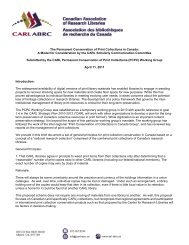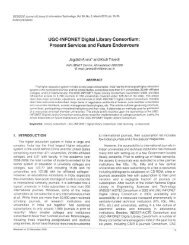PDF - CARL - ABRC
PDF - CARL - ABRC
PDF - CARL - ABRC
Create successful ePaper yourself
Turn your PDF publications into a flip-book with our unique Google optimized e-Paper software.
Introduction<br />
The changes in scholarly communication have been well documented in numerous reports and<br />
articles over the last decade. Today most scholarly journals and a growing number of monographs<br />
are distributed in digital format over the Internet. In the near future, it will be common for<br />
scholarly publications to be “enhanced with embedded graphics, audio and video materials, all<br />
linked with datasets and applications needed to manipulate data, etc” 1 . Moreover, user<br />
expectations in the digital world often involve easy, immediate, and free access to content. In<br />
addition, the rates of technological change are not expected to wane anytime soon, but rather<br />
accelerate.<br />
This report presents the result of an environmental scan of the Canadian academic publishing<br />
landscape undertaken in January-February 2010 on behalf of the University of British Columbia<br />
Library. The purpose of the scan was to identify new models of peer-review scholarly publishing<br />
in Canada, with a particular focus on open access and library-publisher collaborations. The<br />
methodology involved a review of the literature and interviews with stakeholders in the Canadian<br />
academic publishing community.<br />
In Canada, most scholarly publications are still produced by traditional publishers (scholarly<br />
societies, commercial publishers, and academic presses), and are made available via subscription<br />
or purchase. Many are in the social sciences and humanities. However, scholarly publishing in<br />
Canada, as elsewhere, is in a state of flux. Traditional roles are becoming blurred and new models<br />
are emerging. The review found three important factors that are contributing to the deployment of<br />
these new models:<br />
1. New technologies, in particular the Internet and publishing management software, are<br />
having a huge impact on academic publishing and distribution in Canada. Open Journal<br />
Systems (OJS) developed by the Public Knowledge Project, for instance, is an open source<br />
software system for managing journal publishing processes. It is currently being used by<br />
approximately 5,000 journals around the world. OJS, and other similar platforms, manage<br />
the journal’s workflow from manuscript submission to publication making it significantly<br />
easier to publish and also reduce the costs associated with publishing. These new<br />
technologies are enabling libraries, scholars, and student groups to become more active<br />
players in scholarly publishing.<br />
2. Synergies Canada is a collaborative initiative of twenty-one Canadian universities. Led<br />
by the Université de Montréal (with the Consortium Érudit), the project has four additional<br />
regional partners: Simon Fraser University, University of New Brunswick, University of<br />
1 Brown et al. pg. 14<br />
3












